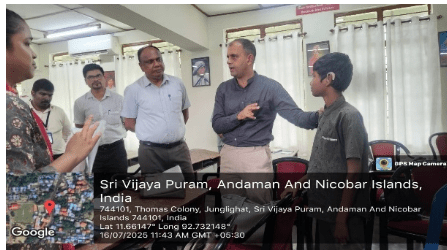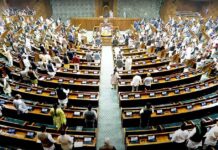Sri Vijaya Puram: In a quiet classroom at Government Secondary School, Junglighat, a child heard a sound for the very first time. The moment, unassuming to an outsider, unfolded as a powerful breakthrough during a special awareness and empowerment session for Children with Special Needs (CwSN) held earlier today.
Organised under the guidance of the Director (Education), the session combined expert virtual guidance with offline, real-time assessments, becoming more than just a medical event. For the 18 children with hearing impairments and their families who attended, it was a rare opportunity to understand, access, and experience assistive technology tailored to their specific needs.
The event featured a live virtual session with Dr. Ravi Kapoor, an eminent audiologist and speech-language pathologist from Government Medical College Hospital, Sector 32, Chandigarh. Known for his extensive experience in both clinical and academic circles, Dr. Kapoor delivered a presentation that broke down the science of hearing loss into language parents and educators could relate to.
From explaining the different types of hearing loss to the maintenance of hearing aids, the session sought to bridge the gap between medical knowledge and everyday care. But perhaps more crucial was the message Dr. Kapoor underscored, hearing impairment, when addressed early and correctly, can be navigated successfully.
On the ground, the focus shifted to assessments led by speech therapist Sakshi Baidya. Working in close coordination with the Education Directorate, she checked each child’s hearing aid for functionality, conducted speech and hearing screenings, and offered instant feedback to families.
What made the session stand out was not just the expertise on display, but the hands-on, personalised approach. Parents received guidance tailored to their child’s device, usage habits, and environmental challenges. For many, it was the first time they had access to such targeted support without having to travel to the mainland.
The session’s most emotional highlight came when a child, previously unaided and unresponsive, was fitted with a hearing aid and reacted audibly for the first time. The child’s smile, followed by wide-eyed recognition of a parent’s voice, moved both families and educators in the room. “It was like watching a wall crumble,” said one teacher present, describing the moment.
In addition to screenings, a live demonstration on the fitting, usage, and care of hearing aids was conducted by Baidya. The visual, step-by-step method enabled parents and special educators to understand both the technical and emotional aspects of device integration into a child’s daily routine.
The program also helped clarify common misconceptions, such as whether a child can sleep with hearing aids on, or how to deal with peer interaction at school. These practical insights brought the session closer to daily realities, rather than limiting it to a medical framework.
While awareness campaigns around hearing loss often remain limited to poster days or generic lectures, today’s hybrid model, blending clinical rigor with empathetic engagement, may well serve as a replicable template across the Islands.
The Director (Education), while appreciating the effort of the education and medical teams, reaffirmed the administration’s commitment to inclusive learning environments. As more children in the UT’s schools begin to access tools like hearing aids, there’s a growing understanding that inclusion goes beyond ramps and scribes, it includes listening, literally and metaphorically.
As the children filed out with devices adjusted and minds lighter, the air in Junglighat wasn’t just filled with sound, it was filled with hope.





